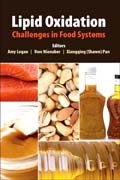
Lipid Oxidation: Challenges in Food Systems
Logan, Amy S.
Nienaber, Uwe
Pan, Xiangqing (Shawn)
Lipid oxidation in food systems is one of the most important factors which affect food quality, nutrition, safety, color and consumers' acceptance. The control of lipid oxidation remains an ongoing challenge as most foods constitute very complex matrices. Lipids are mostly incorporated as emulsions, and chemical reactions occur at various interfaces throughout the food matrix. Recently, incorporation of healthy lipids into food systems to deliver the desired nutrients is becoming more popular in the food industry. Many food ingredients contain a vast array of components, many of them unknown or constituting diverse or undefined molecular structures making the need in the food industry to develop effective approaches to mitigate lipid oxidation in food systems. This book provides recent perspectives aimed at a better understanding of lipid oxidation mechanisms and strategies to improve the oxidative stability of food systems. Five chapters on naturally-derived antioxidants that focus on applications within food systemsContributors include an international group of leading researchers from academic, industrial, and governmental entitiesDiscusses the oxidative stability of enzymatically produced oils and fatsProvides overviews on the complexities of lipid oxidation mechanisms, and emulsion systems most suseptible to rapid lipid oxidation INDICE: PrefaceChapter 1: Challenges in Elucidating Lipid Oxidation Mechanisms: When, Where, and How do Products Arise?Chapter 2: Challenges in Analyzing Lipid Oxidation: Are One Product and One Sample Concentration Enough?Chapter 3: Oxidation in Different Food Matrices: How Physical Structure Impacts Lipid Oxidation in Oil-in-Water Emulsions and Bulk OilsChapter 4: Substrate and Droplet Size: Important Factors for Understanding Aqueous Lipid OxidationChapter 5: The Role of the Interfacial Layer and Emulsifying Proteins in the Oxidation in Oil-in-Water EmulsionsChapter 6: Oxidative Stability of Enzymatically Processed Oils and FatsChapter 7: The Polar Paradox: How an Imperfect Conceptual Framework Accelerated Our Knowledge of Antioxidant BehaviorChapter 8: Role of Hydrophobicity on Antioxidant Activity in Lipid Dispersions: From the Polar Paradox to the Cut-Off TheoryChapter 9: Understanding Antioxidant and Prooxidant Mechanisms of Phenolics in Food LipidsChapter 10: Antioxidant Evaluation and Antioxidant Activity MechanismsChapter 11: Strategies to Minimize Oxidative Deterioration in Aquatic Food Products: Application of Natural Antioxidants from Edible MushroomsChapter 12: The Natural Antioxidant Ergothioneine: Resources, Chemical Characterization, and ApplicationsChapter 13: Rosemary and Green Tea Extracts as Natural Antioxidants: Chemistry, Technology, and ApplicationsChapter 14: Using Natural Plant Extracts to Delay Lipid Oxidation in FoodsChapter 15: Strategies to Prevent Oxidative Deterioration in Oil-in-Water Emulsion Systems: Canola-Based Phenolic Applications
- ISBN: 978-0-12-810229-9
- Editorial: Academic Press and AOCS Press
- Encuadernacion: Rústica
- Páginas: 548
- Fecha Publicación: 19/08/2016
- Nº Volúmenes: 1
- Idioma: Inglés
